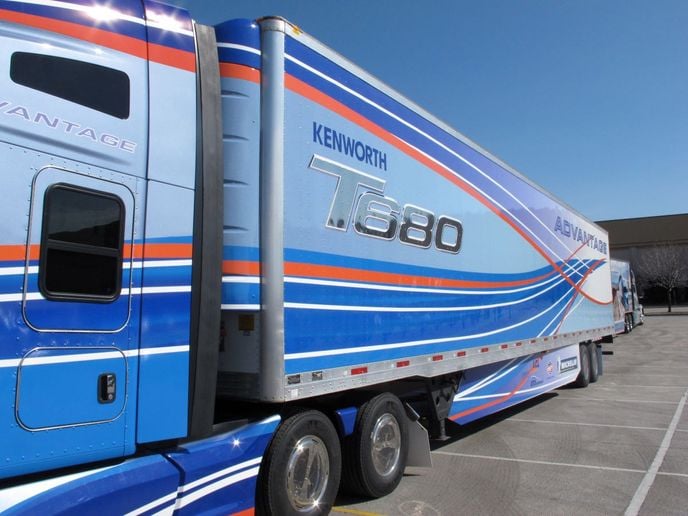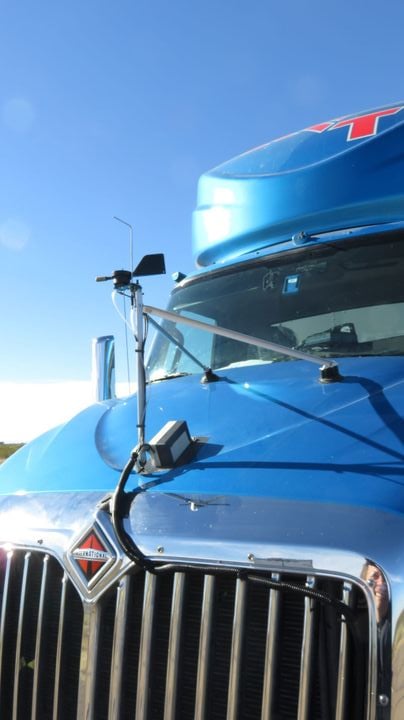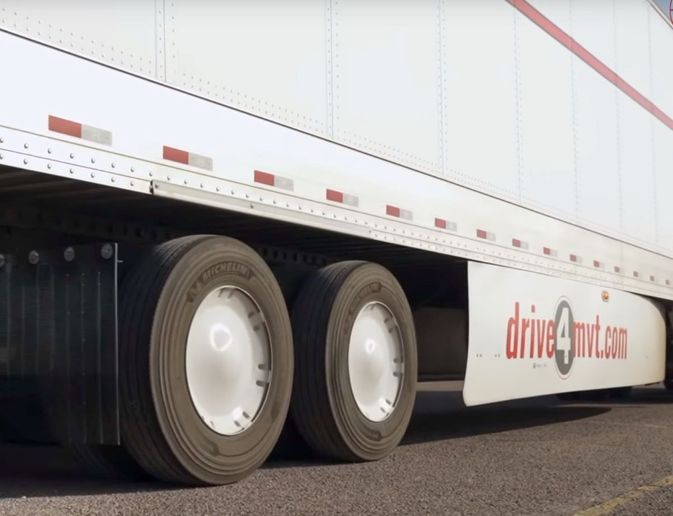Trucker Access › Forums › Diesel News › Don’t Give up on Trailer Aerodynamics – Fuel Smarts
- This topic has 0 replies, 1 voice, and was last updated 10 months, 2 weeks ago by
 EazyRiDer66.
EazyRiDer66.
-
AuthorPosts
-
June 12, 2024 at 2:45 am #25153
 EazyRiDer66Keymaster
EazyRiDer66Keymaster

Aerodynamic add-ons are evolving and improving. What worked 10 years ago is still good, but the products we see today are even better. It might be time to take a new look at aero.
In the quest to decarbonize road transport, electric trucks get all the hype these days, but industry has recently concluded that electrification on a scale that matters is still a long way off. Since there is some degree of urgency in dealing with climate change, we can’t afford to wait for the perfect solution.
The second-best solution now is using less fossil fuel to power the existing fleet.
At the Advanced Clean Truck Expo in Las Vegas in May, Shelley Simpson, the president and incoming CEO at J.B. Hunt Transport raised eyebrows telling the crowd her company was pursuing avenues other than electrification to achieve its carbon-reduction goals, including going all-in on spec’ing more aerodynamic trucks and trailers.
“We recently announced an ambitious goal to reduce carbon emission intensity 32% by 2034, starting for a 2019 baseline,” she said. “We will get there by focusing in three key areas: alternative powered equipment, budgeting fuel, and improved fuel economy.”
The strategy is working. Simpson reported an 18% reduction in greenhouse gas emission intensity since 2019. The company has cut CO2 emissions from 120 tons per million-ton-miles to 94 tons per million ton-miles in five years.
And aero efficiency played a key role in those reductions. Consider that a 1 mpg increase in fuel efficiency (from 7 to 8 mpg) would save almost 1,800 gallons per year. That would reduce CO2 emissions by about 20 tons per year per truck. And at current fuel prices of $3.60 per gallon, savings could be around $5,000 per year.
Faster GHG Reduction Results
Aerodynamic improvements offer immediate reductions in CO2 emissions and immediate reductions in operating cost.

Mesilla Valley Transportation Solutions test aero products on a track in Pecos, Texas. An array or sensors, measuring devices and analytics get very accurate results that can be transposed to match any fleet operating environment in North America.
Photo: Mesilla Valley Transport Solutions
The reductions are smaller in scale than could be achieved by trucks that use no fossil fuel at all, but that out of the question for most fleets at present.
What is within reach, on a nationwide scale, is millions of gallons of fuel not burned to move freight. On such a scale, even a few tenths of a mile-per gallon per truck matter.
If you’re a 48-state, general commodity dry van fleet you’re behind the curve today if you’re not at or close to 7 mpg. That’s not a particularly tall order in 2024.
Fleet Average Fuel Economy Tops 7 mpg
In its most recent Annual Fleet Fuel Study, published in 2022, the North American Council for Freight Efficiency (NACFE), said the average fleet-wide fuel economy of the trucks in this study was 7.23 mpg in 2021 — a slight increase from the 7.15 in 2017.
Compare that to the national average fleet fuel economy of about 6.2 mpg in the same timeframe (that number was derived from IFTA fuel tax reporting).
That said, many over-the-road fleets now claim 8 mpg as their fleet average. There are plenty of trucks making 10 mpg these days. There are even documented reports of fleet trucks running 12 mpg.
Think about that.
That’s double the fleet average from 10 or 15 years ago, according to data from the Federal Highway Administration.
Looking at it another way, that’s half the CO2 emissions of those older trucks. And a fraction of the NOx emissions and other criteria pollutants as well.
Up Your Fuel Savings Game
So, if you’ve been considering upping for fuel economy game but thought we had reached peak aero, think again. There are still significant savings to be had.
“At highway speeds, there’s a mile per gallon almost with just some basic treatment,” says Daryl Bear, lead engineer and COO of MVT Solutions. “You can put on a skirt that it gives you a couple percent or skirts that give you seven or eight percent. Those aren’t common but they are out there.”
MVT Solutions, closely associated with Mesilla Valley Transportation — a fleet renown for fuel efficiency — does fuel economy testing at track near Las Cruces, New Mexico. Bear equips the test trucks with a variety of data acquisition systems and sensors such as fuel flow meters, aerodynamic sensors, high precision GPS, etc., along with sophisticated analytics that account for weather, duty cycles, driver behavior and more.
But best of all, many of the results of his fuel economy testing are published on the MVTS website and available for public review.
Investing in Aero
Where to start?
There are many aero products on the market, and truthfully, some are better than others. Some provide greater return on your investment, while others that perform well may come with a ton of maintenance issues — like the trailer tails that were popular some years ago.
They proved very effective when drivers remembered to deploy them.
Acquisition costs were considered acceptable, but reliability proved to be the trailer tails’ Achillies heel. Maintenance and repair issues quickly overshadowed the fuel saving benefits.
Today, variations on treatments for the back of the trailer are proving equally or nearly as effective as the folding trailer trails, but with few or none of the maintenance headaches.
Even something as basic as trailer skirts can vary widely in effectiveness, and by extension, ROI.
“You need to consider four factors when selecting trailer skirts” says Bear. “Fuel savings, cost, durability and maybe the most critical, the operating environment.”
For maximum effectiveness, a trailer skirt would extend from the landing gear to the back bumper, and from the side rail on the trailer to inches above the pavement. Practically speaking, a skirt so close to the pavement wouldn’t last a week in real-world service. So, you give up some portion of the aero effectiveness to preserve the life of the skirt and reduce the maintenance liabilities.
“Some fleets might want a shorter skirt because of where they operate,” says Bear. “That’s a trade-off that must be considered.”
Treatment for the back of the trailer poses a similar conundrum. The full tails produce the best results, but there come with a bunch of baggage. The more modern tail systems are shorter and less obtrusive and deploy automatically. Like the skirts, the trade-off is slightly less aero performance, but significantly fewer maintenance issues.
Mesilla Valley Transportation were big trailer-tail users,” Bear says. “They have switched to the Michelin kit — the whole system: skirts and the rear kit.
“People realize there are savings to be had at the back of the trailer, but there are also operational limitations that boat tails fell short in meeting. These low-profile designs from Michelin and Transtex provide great alternatives. Savings may be lower than with boat-tails, but the newer designs are always deployed and have zero maintenance.”
Some Honest Test Results
Mesilla Valley Transportation Solutions is an unbiased, third-party fuel economy testing service that evaluates fuel saving products, including aerodynamic devices. Some reports are commissioned by the suppliers, others are testing independently by MVTS and published openly on the website with the suppliers’ consent.

Aerodynamic mudflaps and wheel covers can yield surprising results. Seeming small improvements can add up to big savings when considered as a system.
Photo: Mesilla Valley Transport Solutions
The MVT fleet has relied on this testing program since 2012 to evaluate products with real-world fuel savings.
Note that the test fuel savings are expressed on gallons saved per 1,000 miles as well as a percentage. The gallons-saved metric is useful number, but it may not apply directly to your fleet. It reflects results achieved at the test track at a prescribed speed with weather conditions averaged to a national average standard. But, the numbers provide very realistic baselines from which to compare products.
The best part is, MVTS shares the results, publicly, at no charge. It’s an amazing resource for fleets looking to squeeze all the fuel savings possible from their aero investment.
Consider All Your Options
Bear says these are exciting times for aerodynamic technologies, and fleets should be going all-in on building the best possible aero profiles. With so many solid options on the market, grabbing a mile per gallon, maybe two, is easier than it once was.
And it you believe your options are limited to one or two devices, think again.
“The old myth is that in aerodynamics 1+1 does not equal 2,” Bear says. That’s just what it is, a myth.
“When you measure in gallons consumed over a distance rather than a percentage, the savings do stack up. The exception is when one product affects the air flow of another. Consider pairing skirts with aero fenders and gap reducers, for example. The results can be extraordinary.”
-
AuthorPosts
- You must be logged in to reply to this topic.